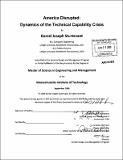America disrupted : dynamics of the technical capability crisis
Author(s)
Sturtevant, Daniel Joseph
DownloadFull printable version (27.21Mb)
Alternative title
Dynamics of the technical capability crisis
Other Contributors
System Design and Management Program.
Advisor
J. Bradley Morrison.
Terms of use
Metadata
Show full item recordAbstract
This study investigates the cause of the nearly twenty-five year decline in the percentage of U.S. born undergraduates earning degrees in engineering. This dramatic decline has occurred despite incredibly high pay and low unemployment among individuals holding engineering degrees. On the surface, this situation appears to be violating the basic laws of labor-market supply and demand. A system dynamics model was created to represent the institutional forces and feedback loops present in the real-world system. This model internally represents the economic forces governing the choice to pursue science, technology, engineering, and mathematics (STEM) education, distinguishing features of highly quantitative knowledge that constrain its transmission, and factors determining the overall quality of STEM education in our schools. This work presents a theory that high industry pay for STEM workers and low pay for STEM K-12 teachers directly cause long-term labor shortages that are self perpetuating. A scarcity of STEM workers will cause wages to rise as employers bid up the price of those skills in the short-term. Schools are left with fewer qualified and lower quality teachers. This makes labor shortages worse ten to twenty years down the road. The fact that mathematics knowledge is highly sequential with strong dependencies on past-performance exacerbates the situation. Students who fall behind in mathematics find it nearly impossible to catch up. (cont.) This work explores many societal shifts that occurred in the 1950's through 1980's that could have resulted in the perplexing behavior seen from 1985 until the present day. Finally, policy proposals to correct the situation are simulated in the model to test their ability to move the system in a more positive direction. The system is found to exhibit "tipping point" behavior. Small reforms will have negligible impact while larger reforms have the potential to make the system move into a fundamentally better pattern of behavior, but only after considerable delays. In addition, this work presents a speculative hypothesis for the cause of Kondratieff economic long-waves briefly in an appendix based on unanticipated behaviors present in portions of the model.
Description
Thesis (S.M.)--Massachusetts Institute of Technology, System Design and Management Program, 2008. Includes bibliographical references (leaves 151-154).
Date issued
2008Department
System Design and Management Program.Publisher
Massachusetts Institute of Technology
Keywords
System Design and Management Program.